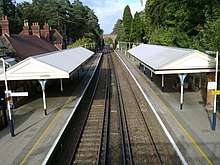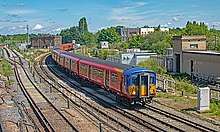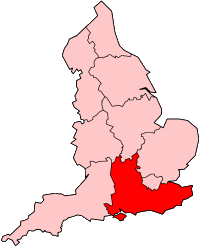New Guildford line
The New Guildford line, presently operated by South Western Railway, is a commuter line between London Waterloo and Guildford. It branches off the South Western Main Line just south of Surbiton, at the same point as the short branch line to Hampton Court. On timetables, trains on this route are advertised as going to Guildford via Cobham.
| New Guildford line | |
|---|---|
| Overview | |
| Type | Suburban rail, Heavy rail |
| System | National Rail |
| Status | Operational |
| Locale | Surrey South East England |
| Termini | Surbiton Guildford |
| Operation | |
| Opened | 1885 |
| Owner | Network Rail |
| Operator(s) | South Western Railway Southern |
| Rolling stock | Class 377, Class 455, Class 456 |
| Technical | |
| Track gauge | 1,435 mm (4 ft 8 1⁄2 in) standard gauge |
| Electrification | Third rail 750 Vdc |
New Guildford line | ||||||||||||||||||||||||||||||||||||||||||||||||||||||||||||||||||||||||||||||||||||||||||||||||||||||||||||||||||||||||||||||||||||||||||||||||||||||||||||||||||||||||||||||||||||||||||||||||||||||||||||||||||||||||||||||||||||||||||||||||
|---|---|---|---|---|---|---|---|---|---|---|---|---|---|---|---|---|---|---|---|---|---|---|---|---|---|---|---|---|---|---|---|---|---|---|---|---|---|---|---|---|---|---|---|---|---|---|---|---|---|---|---|---|---|---|---|---|---|---|---|---|---|---|---|---|---|---|---|---|---|---|---|---|---|---|---|---|---|---|---|---|---|---|---|---|---|---|---|---|---|---|---|---|---|---|---|---|---|---|---|---|---|---|---|---|---|---|---|---|---|---|---|---|---|---|---|---|---|---|---|---|---|---|---|---|---|---|---|---|---|---|---|---|---|---|---|---|---|---|---|---|---|---|---|---|---|---|---|---|---|---|---|---|---|---|---|---|---|---|---|---|---|---|---|---|---|---|---|---|---|---|---|---|---|---|---|---|---|---|---|---|---|---|---|---|---|---|---|---|---|---|---|---|---|---|---|---|---|---|---|---|---|---|---|---|---|---|---|---|---|---|---|---|---|---|---|---|---|---|---|---|---|---|---|---|---|---|---|---|---|---|---|---|---|---|---|---|---|---|---|---|
| ||||||||||||||||||||||||||||||||||||||||||||||||||||||||||||||||||||||||||||||||||||||||||||||||||||||||||||||||||||||||||||||||||||||||||||||||||||||||||||||||||||||||||||||||||||||||||||||||||||||||||||||||||||||||||||||||||||||||||||||||
Rush hour services provide two (inbound) morning services and one (outbound) evening service non-stop between Surbiton and Waterloo. Off-peak services run twice per hour (once on Sundays) and are slower, stopping at all intermediate stations except between Surbiton and Wimbledon.[1]
The line was electrified using the 660 V DC third rail system as far as Claygate in 1916 and for the full route to Guildford in 1925.
Current services
At present on Monday to Saturday there are two trains per hour to Guildford. These trains stop at Vauxhall, Clapham Junction, Earlsfield, and Wimbledon then all stations between Surbiton and Guildford.
There is one additional train during the morning peak period to London and conversely in the evening to Guildford on weekdays. This extra train runs non-stop between London Waterloo and Surbiton in both directions. On Sundays there is just one train per hour in each direction.
South Western Railway also operates another service from Waterloo to Guildford which runs via the Mole Valley line between Raynes Park and Leatherhead then follows the branch through Bookham and joins the New Guildford line at Effingham Junction and runs in parallel with the Cobham trains to the terminus at Guildford. Southern Railway also operates peak time services between Guildford and Effingham Junction. These trains go to London Victoria and London Bridge via Sutton and West Croydon, with one train per hour in each direction on both routes.
On 9 May 2011 Network Rail applied to the local planning authority to extend the platforms at Hinchley Wood, Claygate, Oxshott and Cobham to take 10-car trains as part of a 2012/13 Network Rail plan that included Effingham Junction, Horsley, Clandon and London Road (Guildford).[2][3]
History
The New Line was opened on 2 February 1885 by the London and South Western Railway.[4] Successor companies to run the line were the Southern Railway, British Rail Southern Region, later Network SouthEast, South West Trains, and currently South Western Railway. A note on the geology of the line as revealed by the construction of the cutting at the Guildford end was made by Goodwin-Austen in 1884.[5] Originally the line left the main line at Hampton Court Junction with two parallel tracks off the main line. The bridge just south of the down line junction is to this day big enough for two tracks when it now only has to accommodate one. In 1908 the up line was diverted under the main line to reduce congestion. Details of this venture were noted in The Railway Magazine in 1908 which referred to the bringing into use of a "new burrowing line".[6]
Electric train service and its development since 1916

The section of the New Guildford line from London Waterloo to Claygate was the final suburban electrification carried out by the London and South Western Railway, with the first services on 20 November 1916.[7] The journey from Claygate to Guildford was then a steam hauled service.[8] The journey from Waterloo to Claygate took 29 minutes on commencement of the electric service which was supplemented by steam hauled services during the mornings and evenings.[9] The First World War halted the LSWR’s electrification program,[10] and the Claygate to Guildford electrification was completed under the auspices of the Southern Railway, with the first electric train arriving at Guildford station on 12 July 1925.[11] A new bay platform, now Platform 1, was added at the north-east end of the station to cater for the electric trains as the Portsmouth line wouldn't be electrifed until 1937. Until then down steam trains had used what is now Platform 2.[12]

Currently electric train stock is stabled and serviced at Wimbledon and, until 1993, at Effingham Junction. The latter is now used by Colas Rail as a servicing centre for multiple-purpose track maintenance vehicles (MPV) for Network Rail.[13] From electrification to the early 1960s train stock was formed of 3 and latterly 4 car 3SUB and 4SUB units.[14] In the early 1940s a new 4SUB was introduced. For a while in the late 1950s and 1960s the line was the only route from Waterloo that had 4SUB units substituted by EPB units. For many years new train stock was tested for long periods on this route. New mainline 4LAV units were tried out in public service in the spring of 1932 on the Waterloo – Cobham – Guildford route, where a publicity shot was taken of a unit carrying headcode H with a bar above, the original route code for the line.[15] The line received the first post-World War 2EPB electric stock that became the standard for British Railways Southern Region for many years.[16] In January 1952, 4EPB set number 5001 entered service on the line.
For most of the life of the New Guildford line, only second (formerly known as third) or standard-class stock has been available. For a brief period starting in October 1973, first class service was provided but the total number of seats was much reduced from the former second class only stock, from 772 to 560 seats, and this resulted in much dissatisfaction due to the consequent overcrowding.[17] However, the first-class train stock used consisted of 4VEPs and, owing to a shortage of this stock available for the stopping services between Waterloo and Woking,[18] first-class service was abruptly withdrawn from the New Guildford line and second-class only service reinstated. During the period of first-class service, a number of trains ran as stopping services to and from Portsmouth. Very occasionally, during times of disrupted working, 4COR sets with 2HAL and 2BIL units that had been cascaded from the main line would be seen – the former causing substantial delays owing to the lack of doors for quick rush-hour loading.
Current rolling stock

Currently the services to Guildford and London Waterloo are using Class 455 sets built in the early to mid-1980s, which have now all undergone an extensive refurbishment program which was completed in 2008. Refurbished 2 car sets of Class 456 formerly in service with Southern (Railway), have been used since 2017 to extend peak hour services and some off peak services to 10 car operation.[19]
Accidents and incidents
1925
Shortly after the line to Guildford was electrified there were three minor accidents. In each case the drivers lost control of their trains due to unfamiliarity with the new style Westinghouse brake equipment. These incidents happened on 16, 23 and 31 July. The report of the Ministry of Transport Inspector[20] notes that the three trains were all coming into the new terminal bay platform that had recently been installed for the electric services.
1953
On 18 September there was another incident of the same type as in 1925 when a train overran the buffers at Guildford and collided with the station offices, killing the assistant station master. Once again the driver was not familiar with the new type of brakes that had been introduced with the new train stock – this time 1951 electro pneumatic brake electric multiple units.[21]
2010
On 5 November 2010, a lorry fell off a bridge over the railway line near Oxshott railway station, landing on the 3:05 pm South West Trains service from Guildford to London Waterloo.[22] The lorry driver and one passenger suffered serious injuries; a further five passengers suffered minor injuries.[23]
References
- South Western Railway publication, 'Train Times 10 December 2017 to 19 May 2018' (Pub ref: PTT11 1217)
- "CP4 Delivery Plan" (PDF). Archived from the original (PDF) on 2 September 2009. Retrieved 4 December 2011.
- [Date of Issue: 09/05/2011 Weekly List No: 2011/18 ]
- White, H P (1982). A Regional History of the Railways of Great Britain, Vol 2, Southern England. Newton Abbot: David and Charles. p. 127. ISBN 0 7153 8365 5.
- Godwin-Austen, H. H. (1884). "On the New Railway-Cutting at Guildford:--The Pleistocene Sands and Drift-Gravels observed there". Quarterly Journal of the Geological Society. 40 (1–4): 599–613. doi:10.1144/GSL.JGS.1884.40.01-04.50.
- The Railway Magazine Vol XXIII July–December 1908 p521. Google Books. 1 January 1909. Retrieved 4 December 2011.
- "Suburban Electric Railway Association". Retrieved 24 May 2015.
- "Text from Electric Railway J Nov 11, 1916 London Letter Section" (PDF). Retrieved 4 December 2011.
- "reference to ELECTRIC RAILWAY JOURNAL". Archive.org. Retrieved 4 December 2011.
- "Suburban Electric Railway Association". Retrieved 24 May 2015.
- "Merrow Residents' Assn Iss 22 Autumn 2007". Merrowresidents.org.uk. Retrieved 4 December 2011.
- "Southern Railway Buffer Stop Collisions, Report to Secretary, Ministry of Transport, Major G L Hall" (PDF). HM Stationery Office. 18 August 1925.
- MPVs at Effingham Junction www.bloodandcustard.com; Retrieved 2015-03-01
- "Suburban Electric Railway Association – History Zone – Southern Suburban Electrification". Emus.co.uk. Retrieved 4 December 2011.
- "Southern Electric Group". Southernelectric.org.uk. Archived from the original on 3 December 2013. Retrieved 4 December 2011.
- "To Guildford via Cobham" (PDF). Retrieved 4 December 2011.
- "Hansard 5 July 1974 vol 876 cc905-16". Hansard.millbanksystems.com. 5 July 1974. Retrieved 4 December 2011.
- http://www.therailwaycentre.com/Resource_data/All%20Time%20class%20EMU.pdf
- "Collision near London Waterloo station, 15 August 2017" (PDF). Rail Accident Investigation Branch. p. 2 (para. 2). Retrieved 20 December 2017.
- "Southern Railway Buffer Stop Collisions, Report to Secretary, Ministry of Transport, Major G L Hall" (PDF). HM Stationery Office. 18 August 1925.
- "British Railways Southern Accident Report, Report to Secretary, Ministry of Transport and Civil Aviation, Brig C A Langley" (PDF). HM Stationery Office. 18 January 1954.
- "Several injured as lorry falls on to a train". BBC News. 5 November 2010.
- "Investigation into an accident involving a heavy goods vehicle and a train near Oxshott, Surrey, on 5 November 2010". Rail Accidents Investigation Branch. Archived from the original on 12 November 2014. Retrieved 9 November 2010.
Further reading
| Wikimedia Commons has media related to New Guildford Line. |
- Mallinson, Howard (2006). Guildford via Cobham: The Origins and Impact of a Country Railway. ISBN 978-0-9543934-2-7.
- Mitchell, Vic; Smith, Keith (1 April 1990). Branch Lines around Effingham Junction from Guildford, Leatherhead and Hampton Court. Middleton Press. ISBN 978-0-906520-74-1.
